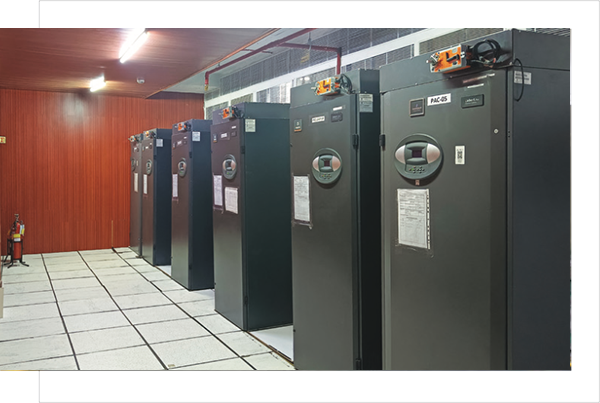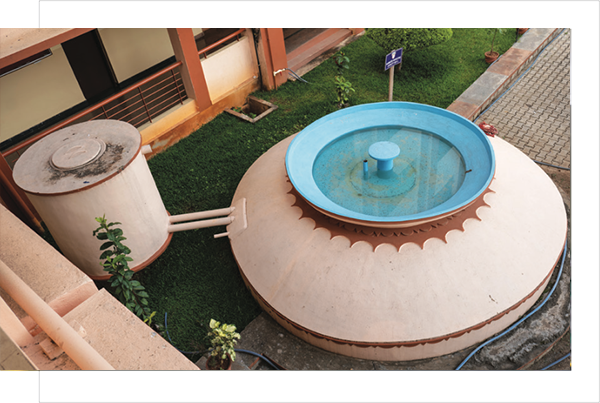The environment has a direct impact on the health and well-being of our customers, our employees and our communities. It is therefore important that we strive to mitigate our own impact, and where possible, influence positive environmental practices.
We make concerted efforts to decarbonize our operations, wherever possible, in order to reduce our overall carbon footprint. With a strong focus on environmental responsibility, climate protection, and an optimal use of natural resources, we are maximizing resource efficiency while doing our bit for a greener and cleaner planet.
No risk identified


We employ a two-pronged approach towards energy efficiency. We promote behavioral changes even among our associates by encouraging conservation of energy and smart management of lighting, heat ventilation and cooling requirements. Our design considerations and operational practices weave energy efficiency into our day-to-day operations. Some of the steps adopted include efficiently utilizing our energy sources, lowering our carbon emissions, monitoring our energy consumption and putting an efficient waste management plan in place.
With an aim towards power conservation in operation and maintenance of facilities, best practices were implemented through which we were able to save the power consumption of 8.24 Lakhs units per annum, resulting in cost reduction of INR 7.41 Million.
The following are the few major initiatives and interventions completed.

As part of this program objective, we have reduced 3.99 MVA UPS capacity across all our locations in India. In FY22, we reduced the installed capacity to 480 KVA from 640 KVA, which is 25% lesser, in our global village facility in Bengaluru. This has been implemented by analyzing the load pattern over the last two years including an assessment of the future load pattern. Improved intelligent monitoring system in the installed UPS, enables us to track the operation and load pattern remotely. This initiative has also brought down the air conditioning demand for the UPS room space.
Our energy conservation has been estimated at 2.39 Lakh kWh per annum, with a cost savings of INR 44.22 Lakh per annum with ROI of 10 months.
At our global village facility in Bengaluru, we installed VFDs for Air Handling Unit (AHU), which allows the HVAC motors to operate as per the load requirement, instead of running them at constant speed. This has yielded significant energy savings and it also keeps indoor temperatures within the set range of demand.
Units of electricity saved through installation of VFD
The restroom flushing in buildings utilized a pneumatic pumping system. To maintain the pressure at the pumping line, pumps needed to be operated continuously, leading to higher power consumption. To make the system more energy efficient, plumbing lines were modified together with overhead tanks and automatic pumping system, where the water now needs to be filled once or twice a day and water pressure is maintained through gravity force. This reduced the pump operating time by 21% resulting in energy savings of 5,913 units/annum.
The global data center at Bengaluru has Precision Air Conditioning (PAC) units with a total capacity of 86 TR. These units use technologies that are 14 years old, with the power consumption being on the higher side. To optimize the energy consumption, we replaced existing units with inverter technology compressors (PDX PAC units) with a total capacity of 56 TR. It is the highest performing direct expansion floor mount unit in its range, driving up efficiency to 95%. These modulate at compressor and fan levels to decrease the energy consumption. Post installation, the power utilization effectiveness value of the data center has improved from 2.0 PUE to 1.52 PUE. Energy units saved through this initiative is 74,321 units/annum.
The same initiative was implemented at CISCO, our data center at our Bengaluru Whitefield office, where the energy savings was 1.8 Lakh units.
Energy units saved through replacement of PAC units at global data center & CISCO data center at Bengaluru

Our ODC facility at Pune earlier had a common air conditioning system for both the workspace and one of the critical rooms. Due to the pandemic most of the employees were working remotely and there was no need for air conditioning in the workspace area. Since the existing system was operating for the entire floor, including critical rooms, there was a lot of energy wastage. As a mitigation strategy, we installed a separate eco-friendly refrigerant split AC unit for the critical rooms with lesser capacity.
CFL tubes at our Pune and Hyderabad facilities have been replaced with enhanced LED lights which enabled a significant reduction in lighting energy use at these facilities. The move is expected to save 3,701.38 kWh of energy, with payback and zero maintenance cost for five years.
We have committed to making our operations run on 100% renewable energy by 2025. During the year, 77.77% of electricity requirement for our India operations were met by renewable resources. We are constantly working with partners and governments in various states to increase our electricity consumption from renewable resources.
As a responsible organization, we are committed to conserving fresh water to reduce our load on the community. Our water consumption has drastically reduced due to remote working since the pandemic. The 3R (reduce, reuse, recycle) approach is embedded into our operations to ensure minimal freshwater usage and various initiatives have been put in place to achieve this. At most of our facilities, water requirement for flushing, landscaping and HVAC cooling tower is met through recycling.
Wastewater discharge
from our campuses

At our Bengaluru facilities, through our rainwater harvesting & installation of recharging pit initiative we ensure to recharge the groundwater level. These projects helped us to reduce private water purchase by 12,370KL in this financial year. At our Pune facility, existing water aerators were replaced with efficient water aerators, reducing the rate of water flow for taps by 35% without compromising on user comfort. With 100% occupancy of the building, this initiative has the potential to save 1,388 kl/annum.

(Kl)
| Source | FY20 | FY21 | FY22 |
|---|---|---|---|
| Ground water extraction | 4,141 | 9,516 | 12,370 |
| Municipal corporation | 50,003 | 13,716 | 15,384 |
| Private suppliers | 121,134 | 12,672 | 11,352 |
| Packaged water | 4,821 | 426 | 412 |
| Rainwater | 4,120 | 2,551 | 2,712 |
| Total | 184,219 | 38,881 | 42,231 |
Our waste management efforts are driven by the objective to reduce the amount of waste to landfill, while increasing the quantity of recycled/reused waste, in an eco-friendly manner. We focus not only on recycling but also on limiting waste generation. The combination of reduction in waste, waste segregation, recycling, on-site composting and incineration has led to reduced burden on the city landfills.
All the waste generated within our office premises are disposed by authorized recyclers as per legislations. Hazardous, biomedical and e-waste are disposed by recyclers who are authorized by the Pollution Control Board. Printers, toners and cartridges are given back to the partner for refill for reuse.
The organic waste generated within our campus comprise food waste, garden waste and Sewage Treatment Plant (STP) sludge. We treat our organic waste using in-house organic waste composter that converts waste into manure. Sludge generated from STP is dried and blended with this compost. The manure is being used as fertilizer for landscaping within the campus. We also distribute the extra manure to our Mindtree Minds during World Environmental Day and Earth Day.
The inorganic waste consists of all other types of waste, such as paper, plastic, and metal, which are segregated at the source and are disposed off through authorized recyclers. Packing waste like cardboard is reused for couriering the laptops to employees working remotely.
Reuse of metal scrap by our inhouse team to fix handrails for ladders to access overhead tanks resulted in a savings of INR 9.2 Lakh. Construction waste is disposed to our vendor and reused for construction of roads, thus eliminating 380 tons of waste reaching to landfill.
During the year, we also implemented the Well-being Out of Waste (WOW) initiative - a program where recyclable waste is scientifically disposed and sent for recycling. In FY22, we successfully recycled 99.17% of the recyclable waste generated within our office premises.
| Source | Total Quantity (kg) | % |
|---|---|---|
| Electronic | 42.939 | 7.7% |
| Hazardous | 47.212 | 8.5% |
| Inorganic | 4.006 | 0.7% |
| Organic | 44.034 | 7.9% |
| Packaging | 12.315 | 2.2% |
| Other | 405.028 | 73.0% |
| Total | 555.534 | 100.0% |